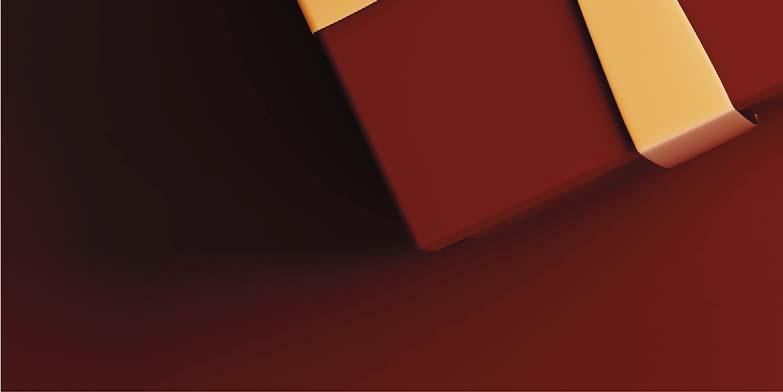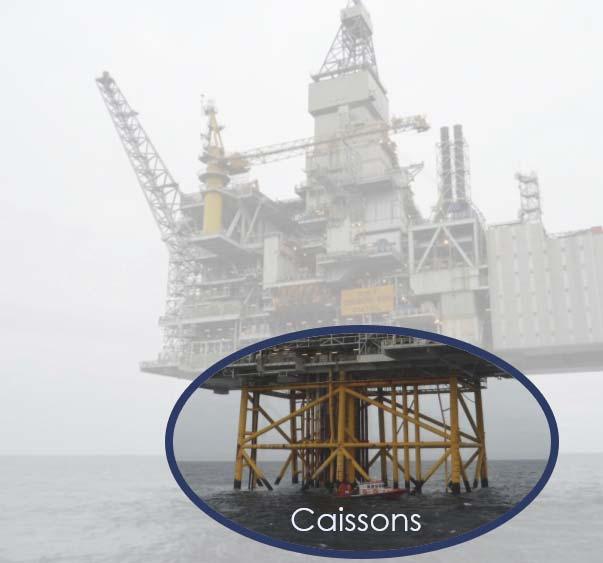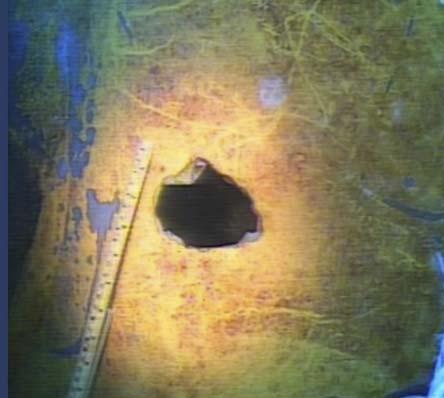
5 minute read
Under wraps
Jean-Francois Ribet, 3X Engineering,
Monaco, recounts the repair of subsea caissons at a North Sea platform, using composite wrapping.










ff shore platforms and their associated subsea pipeline networks have to function in harsh environments. On ageing North Sea platforms, corrosion, structural problems, leaks in seawater caissons and risers, dents, and mechanical damage to pipes and flowlines are all issues faced by operators. These can all hamper the functioning of the platform and production and, at worst, lead to the shutdown of a platform – an unacceptable outcome.
However, it is not easy to solve these problems with traditional solutions, which usually require considerable logistics that can impede operations.
A composite wrapping solution appears to be a new and eff icient way to help platforms to repair these defects, removing the threat of a shutdown, while also being cost-eff icient.
In this context, ‘composite’ means fibre impregnated with resin that will cure and provide high mechanical and chemical properties to sustain and reinforce steel structures for a determined lifetime. 3X Engineering selected Kevlar fibre tape and an epoxy resin for its composite wrapping technology. Due to its high strain at failure properties, Kevlar enables a good composite sleeve deformation in line with pipe elongation. As the composite behaves in the same way as insulant material, there are no galvanic eff ects or cathodic protection issues. Moreover, its resistance to abrasion is good, and Kevlar fibre can be handled without any safety or health risks to the operator. The epoxy resin

is made of a part A and a part B with diff erent ratios, depending on the selected resin. In contrast to polyurethane resin, it is entirely solid and has no volatile components, which enables a simple and eff icient implementation and guarantees the quality of the composite. No water is required during its application on the pipe – an important consideration, given that water is a key cause of corrosion – and it will not create carbon dioxide (CO2) bubbles during the resin reaction; CO2 bubbles can be trapped in composite sleeves and weaken the composite’s eff iciency and lifetime.



The composite has to be designed according to the two main standards, ISO24817 (ISO) and/or ASME PCC2 (ASME), when it is used for treating external/internal corrosion as well as holes or leaks. Depending on the type of defect, the repair’s design lifetime can

Figure 1. View of the subsea caissons.

Figure 2. Measurement of the defects.

Figure 3. Tape wrapping machine monitored by diver.
reach as high as 20 years. ISO and ASME can also be employed to repair dents and cracks, but in the case of the latter a finite element analysis (FEA) is preferable.
Case study
3X Engineering, alongside its partner in the North Sea, was asked to solve corrosion and leak problems on the subsea caissons of an off shore platform. The caissons were experiencing corrosion that had created holes with diameters of up to 300 mm.
The challenge was to implement a solution that took into consideration the harsh environment (e.g. cold water of between 4˚C to 12˚C, depending on the season, and the specific salinity level of the sea), the specific steel grade, and the repair depth, which could range from -5 m to -20 m.
Each composite repair was engineered to restore the serviceability of the caissons. Once the inspection was completed and the defects data received, the company undertook the required analysis and technical off ers, using internal soft ware that complied with ISO and ASME and carrying out a FEA.
The proposed technical solution was to: Clean the caissons and sandblast them in order to achieve at least a SA2.5 surface preparation and a minimum roughness of 60 μm. Cover the hole with plate and a specific subsea filler developed by the company. Cover all of the sandblasted surface with a subsea primer. Prepare the composite tape on the platform using the company’s
BOBiPREG®, an impregnation tool. Wrap the composite tape on the caisson using a hydraulic-driven wrapping machine monitored by the divers.
To ensure the solution was suitable, a number of full-scale tests were performed in real-life conditions. Aft er the first test, the main problem noted was the adhesion between the composite and the steel, because of a combination of low temperatures and the steel grade. The client required 5 MPa, as stated by the ISO standard. The first results were not positive.
A primer was therefore required that could pass the required adhesion test. Once one was selected, a new full-scale test took place and the results met the client’s requirements. The adhesion test, performed by DNV GL Norway, returned results of 11 MPa on average (two times greater than the initial requirement). DNV GL gave its off icial approval to the client, meaning the onsite application could start.
Regardless of the technological advancements in the sector, a subsea repair still remains a challenging intervention. Given the unpredictability of the North Sea, the safety of the divers was a key requirement. The divers were therefore trained to properly apply the composite wrapping. During the application, they were monitored by technicians on the platform through radio and a camera.
Despite delays due to bad weather, the application of the composite wrapping was successful. Depending on the defect, the repair length varied between 780 mm to 2340 mm for a total composite wrapping length of 6800 mm. The wrappings were made both on a straight line and on tee.
Conclusion
The company continues to develop its subsea composite wrapping in order to meet new client demands. One potential avenue is to explore diverless subsea composite wrapping and deep off shore pipe repairs. If necessary, the company can performs tests in hyperbaric chambers to replicate the conditions (e.g. pressure and temperature) of deepwater environments.










